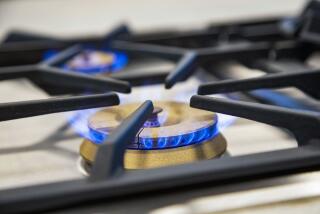Infrared barbecues give a quick sear, but durability is unknown.
INFRARED burners are a hot option on gas barbecues, but are we merely buying marketing sizzle instead of cooking a better steak?
The intense heat of infrared energy, the pitch goes, allows backyard grillers to sear meat the way steakhouse chefs do. Whereas flames and hot air cook food in charcoal or gas barbecues, infrared burners are topped with glass, ceramic or metal that emits radiant heat reaching temperatures of upward of 1,800 degrees -- about three times hotter than traditional barbecues. The high radiant heat supposedly keeps food juicier than gas does and gives cooks more temperature control compared with charcoal.
Manufacturers are installing the expensive infrared units alongside traditional gas burners in most high-end barbecues. In July, Barbeques Galore is premiering its T Grill and Designer Series, models with only infrared burners.
“It’s not about performance, but paying extra for a brand, feature or benefit that makes you the hero,” says Thomas Liu, director of products for the Carlsbad-based company. Prices have yet to be determined.
John Macchia, who has been testing barbecues for eight years at Consumer Reports, says inexpensive grills can perform just as well, and warranties on traditional gas burners often last five to 10 years.
He’s never conducted a longevity test on infrared systems, and many come with warranties good for only two years.
Most infrared barbecues have only two cooking settings: high and off. Though fans insist the intense heat better preserves the flavor in beef and poultry, it can incinerate more delicate foods such as fish or vegetables.
Here are some additional considerations for two new infrared grills whose burners can be adjusted from low to high heat: the Char-Broil Red 3 Zone Infrared Grill and the Napoleon Prestige II.
Advantages
Char-Broil says its Red uses one-third less gas than the average grill because the infrared burners heat faster, cut grilling time in half and produce higher temperatures from lower BTUs. (This grill has 48,000 BTUs, but experts say big numbers don’t matter; it’s how efficiently the BTUs are used.)
The Prestige II has more than 61,000 BTUs and can reach 1,800 degrees in 30 seconds. After two minutes, meat can be moved to a standard gas burner to finish cooking over lower heat -- unless you like ahi steaks charred on the outside and raw in the middle, says Fred Sheldon, who sells barbecues at Trend Setting Islands and Outdoor Products in Redlands.
Manufacturers also tout easy cleanup. The trough-shape bottom on Char-Broil’s Red prevents grease from dripping onto the burners. When the porcelain-coated cast-iron cooking grates are dirty, you can turn on the self-cleaning heat, then brush away the ashes. Most of the juices that spill onto the Prestige II’s stainless steel vaporizing panels are instantly burned by the flames. The resulting puffs of smoke permeate the food.
Drawbacks
The big question is, how well will infrared barbecues hold up? The Char-Broil Red infrared burners come with a two-year warranty. The Prestige II’s infrared burner is covered for five years, and its other gas burners and stainless steel parts have a limited lifetime warranty.
The Prestige II’s infrared heat is directed to a ceramic grid; some manufacturers have turned to other materials because ceramic can crack when exposed to thermal shock (hot, then cold). The Char-Broil Red’s three stainless-steel infrared burners transmit heat to two U-shaped troughs made of porcelain-coated sheet metal, leading some experts to ask: If the metal expands in 700-degree heat, will the porcelain eventually crack?
Consumer Reports’ Macchia prefers a separate infrared rotisserie burner at the back of the grill rather than an infrared surface burner, which has to be monitored closely to prevent any food from becoming toast. He tested a turkey on an infrared rotisserie and said it was juicy, brown and crispy. And for a killer burger? He still uses his 12-year-old gas Weber.
Prices
The Char-Broil Red 3 Zone barbecue, which has 750 square inches of cooking surface, is sold at Home Depot starting at $599. A larger grill with a propane tank gauge, temperature probe and timer is $899.
The adjustable infrared burner is a $150 add-on to the Prestige II, which costs $800 to $1,500 depending on the number of burners and color of the cabinet, lid and doors.
More to Read
Sign up for The Wild
We’ll help you find the best places to hike, bike and run, as well as the perfect silent spots for meditation and yoga.
You may occasionally receive promotional content from the Los Angeles Times.










